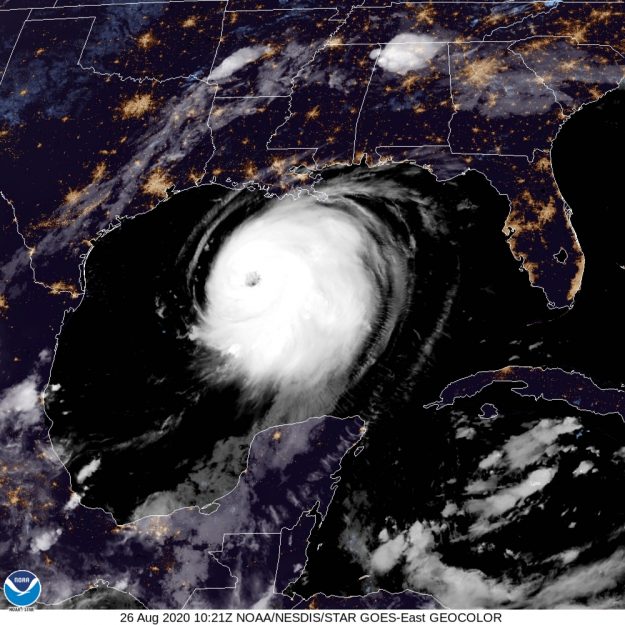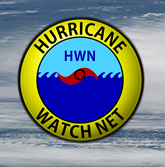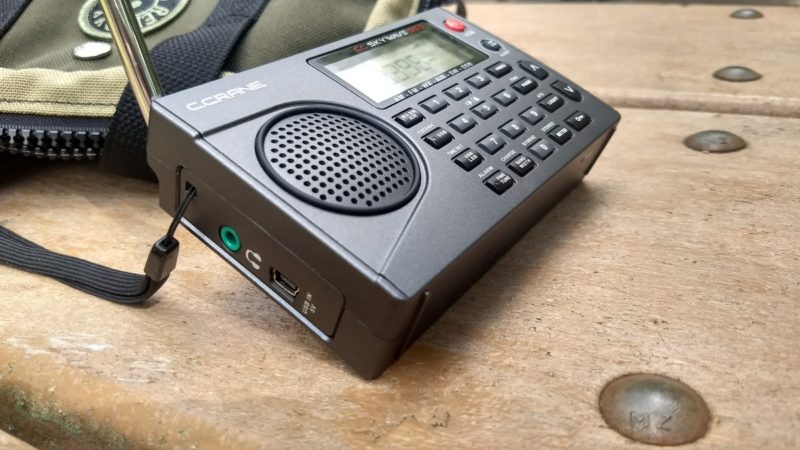 As Hurricane Laura starts to make landfall this evening (Wednesday, August 26, 2020), it is expected to be a category four hurricane—producing extreme winds, life-threatening storm surge and flash flooding.
As Hurricane Laura starts to make landfall this evening (Wednesday, August 26, 2020), it is expected to be a category four hurricane—producing extreme winds, life-threatening storm surge and flash flooding.
This has been an active and early tropical storm season here in North America and September may produce even more named systems.
A few readers have asked about frequencies to monitor the HWN, so I thought I’d share this short primer.
Hurricane Watch Net (HWN)
 The Hurricane Watch Net is a group of amateur radio operators who are trained and organized “to provide essential communications support to the National Hurricane Center during times of Hurricane emergencies.” The HWN focuses on “ground truth” observations (much like SkyWarn nets).
The Hurricane Watch Net is a group of amateur radio operators who are trained and organized “to provide essential communications support to the National Hurricane Center during times of Hurricane emergencies.” The HWN focuses on “ground truth” observations (much like SkyWarn nets).
The Hurricane Watch Net is activated when a hurricane is within 300 statute miles of expected land-fall. The HWN covers the Caribbean, Central America, Eastern Mexico, Eastern Canada, and all US Coastal States.
The HWN operates in both English and Spanish, and is active on 14.325 MHz (upper sideband) during the day and 7.268 MHz (lower sideband) at night. The HWN is known to operate on both frequencies if propagation allows.
The HWN provides updates on their website regarding activation times and frequencies. As an example, here’s the latest for Hurricane Laura:
The Hurricane Watch Net will activate Wednesday morning at 8:00 AM CDT (1300 UTC) on our primary frequency of 14.325.00 MHz. Beginning at 4:00 PM CDT (2100 UTC), we will begin simultaneous operations on 7.268.00 MHz. Once activated, we will remain in continuous operation on both frequencies until the bands close. We will resume operations on those bands just as soon as propagation returns.
Please keep HWN frequencies clear
If you’re an amateur radio operator, please avoid using 14.325 MHz and 7.268 MHz anytime the HWN has been activated.
Monitoring hurricane frequencies
If you have a shortwave radio with a BFO/SSB mode, or a ham radio transceiver–and you live within the propagation footprint–you can monitor the Hurricane Watch Net.
Note that you’ll need to use upper sideband on 14.325 MHz and lower sideband on 7.268 MHz.
You can also monitor the Hurricane Watch Net via a number of WebSDRs on the KiwiSDR network and even potentially via the U Twente WebSDR in the Netherlands if propagation is favorable (although a WebSDR in North America would be preferable).
Click here to view the Hurricane Watch Net website.
If you live in an area prone to hurricanes, tropical storms and other natural disasters, please keep an emergency kit fully-stocked and at the ready. Click here for some ideas about building your own simple kit.


voIP and landlines may fail, a battery powered radio won’t so …
The USA Government owned Radio Marti is in ‘Greenville NC and transmitting towards Cuba. https://docs.radiotelevisionmarti.com/es-CU/2018/10/31/be4580ef-905f-4d34-ba60-5e9f48c82891.pdf
Some transmissions are in DRM, which is capable of transmitting emergency alerts including slideshow of containing maps of the hurricane. They could also transmit Journaline which could be detailed instructions in multiple languages and are indexed.
The High Frequency broadcasts cover a large area, where as HD radio even in the medium frequency band cannot cover anywhere near a larger area.
I should add the in Australia, we have the amateur radio organisation Wireless Institute of Australia Emergency Network which backs up broken mobile and two way radio networks used by the emergency services. Their use of HF will work when the hurricane produces thick cloud cover which prevents communications via satellite. Many cell phone base stations are at the highest location for maximum coverage but as susceptible to wind damage and electricity black outs.
The VoIP Hurricane Net also activates to support the National Hurricane Center’s WX4NHC. This net is primarily Echolink and IRLP along with All Star, D-Star and DMR connections. See voipwx.net
“As Hurricane Florence starts to make landfall this evening (Wednesday, August 26, 2020),“.
Typo or do you know something I don’t?
J
Ouf! Thanks for catching that. Name soup in my head!
Does anyone know of some easily received AM stations in the areas
affected?
WWL New Orleans seems to be too far east this time.
KTRH 740 AM Houston
and if one doesn’t have an SSB receiver it may still be possible to use a second receiver placed near the one used for listening and with volume turned to zero as a rudimentary BFO
A step further, one can piece together a BFO oscillator circuit, like the TenTec 1050, for a few dollars. Thankfully most common radios use a 455KHz IF design.
Or alternatively:
http://sdr.n4but.com/
Also the VoIP Hurricane Net operates to support the National Hurricane Center WX4NHC Station. See voipwx.net
This is a combination primarily of Echolink and IRLP. Also All Star and others systems link in such as DMR and D-Star.